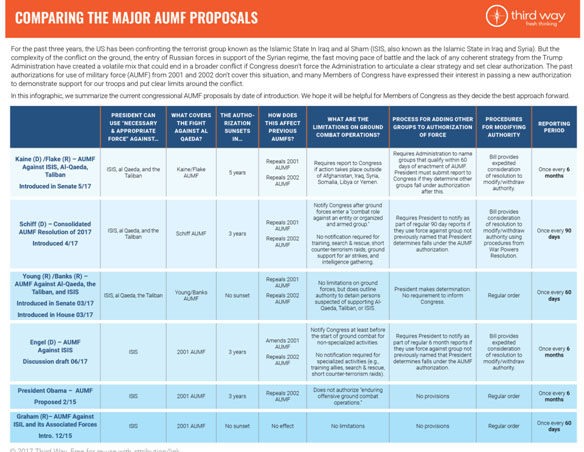A Twist in the Quest for an AUMF Against the Islamic State
Patrick Ryan Alban
On June 29, 2017, the House Defense Appropriations Subcommittee (HAC-D) adopted an amendment proposed by Rep. Barbara Lee (D-CA) to repeal the 2001 Authorization for the Use of Military Force (AUMF). [i] The sunset provision would take effect 240 days after the enactment of the Defense Appropriations Bill currently before Congress.[ii] It surprisingly passed the committee with support from the Republican majority. Only Rep. Kay Granger (R-TX) opposed the amendment. While this provision is highly unlikely to become law, it is a significant development in the debate over a possible AUMF specific to the fight against the Islamic State (ISIL), with potential implications on operations in Afghanistan and elsewhere.
The United States military has conducted the War on Terror for the last 16 years subsequent to passage of the 2001 AUMF, which authorizes the President to:
[U]se all necessary and appropriate force against those nations, organizations, or persons he determines planned, authorized, committed, or aided the terrorist attacks that occurred on September 11, 2001, or harbored such organizations or persons, in order to prevent any future acts of international terrorism against the United States by such nations, organizations or persons.[iii]
Further, the 2001 AUMF constitutes “specific statutory authorization” within the meaning of section 5(b) of the War Powers Resolution.[iv] Al-Qaeda, the organization responsible for the September 11th attacks, has greatly declined in its ability to conduct acts of international terrorism against the United States. The U.S., however, remains engaged against the Taliban, which harbored al-Qaeda as the de facto government of Afghanistan from 1996-2001.
Since Abu Bakr al-Baghdadi declared the establishment of a worldwide caliphate on June 29, 2014, the U.S. has conducted military operations to counter ISIL. In August of 2014, President Obama began ordering U.S. military airstrikes on ISIL forces in Iraq. At the invitation of the Iraqi government, U.S. ground forces have been providing assistance to Iraqi security forces.[v] Special operations forces are fighting alongside counter-ISIL rebel groups inside Syria, despite Syrian and Russian objections.[vi] Interestingly, the current fight against ISIL relies on the 2001 AUMF (and, to a lesser extent, the 2002 AUMF against Saddam Hussein’s regime in Iraq). This legal argument is supported by the fact that ISIL was born out of the remnants of Abu Musab al-Zarqawi’s al-Qaeda in Iraq. This expansive view of the 2001 AUMF is not without controversy.
As military action against ISIL has evolved and increased, legal scholars, human rights groups, and Members of Congress have raised concerns about the President’s authority to use force against the group. There are at least six AUMF proposals currently before the 115th Congress as shown in the table below.[vii] The debate centers on the purpose and scope of the authorization, identification of targeted identities, limitations and conditions (such as on enduring offensive ground combat operations), repeal of previous AUMFs, and Congressional reporting criteria.

A number of issues arise simply determining the scope of a new AUMF. ISIL boasts foreign affiliates in Egypt, Libya, Yemen, Somalia, West Africa and Indonesia. Within the last month, ISIL designated Insilon Hapilon as its emir in Southeast Asia, consolidated Abu Sayyaf and the Maute rebels under its banner, and seized parts of a Marawi City in the Philippines.[viii] Does Congress intend to authorize the President to conduct military operations against ISIL in each of these countries? Will Congress direct a particular effect (counter vs. destroy) which would greatly expand operations by impliedly authorizing offensive ground combat operations against ISIL? Not likely, but words have meaning, especially when planning for the conduct of military operations. Congress is more careful than that, which is why such phrases as “all necessary and appropriate force” can be found in the original 2001 AUMF and the various drafts currently before it.
Another possibility, although just as unlikely, is that the repeal of the 2001 AUMF will be passed into law without a replacement AUMF to continue the fight against the Taliban in Afghanistan. This would destroy a decade and a half long effort by the United States to train, advise, and assist Afghan security forces to provide their own security and ensure Afghanistan can never again be used as a launching ground for terrorist acts against the U.S.
Regardless of the outcome of the AUMF debate in Congress, it is unlikely that U.S. military operations against ISIL or like terrorist groups will cease in the short- or long-term. The President has inherent constitutional powers under Article II as Commander-in-Chief. Neither Congress nor the courts are likely to argue with the President’s exercise of those powers to defend the United States against terrorist threats by ordering special operations raids to capture or kill terrorist leaders, or to conduct drone strikes against the same. Nevertheless, this debate should be closely followed by legal scholars and military officers alike—the successes of our past and the security of our future depend on it.
End Notes
[ii] Id.
[iii] Authorization for Use of Military Force of 2001, Pub. L. No. 107-40, 15 Stat. 224, 224 (2001). Accessed at https://www.congress.gov/107/plaws/publ40/PLAW-107publ40.pdf.
[iv] War Powers Resolution of 1973, Pub. L. No. 93-148, §5(b), 87 Stat. 555, 556 (1973). Accessed at https://www.gpo.gov/fdsys/pkg/STATUTE-87/pdf/STATUTE-87-Pg555.pdf.
[v] See Chuck Hagel & Martin Dempsey, Department of Defense Press Briefing by Secretary Hagel and General Dempsey in the Pentagon Briefing Room (Aug. 21, 2014), https://www.defense.gov/News/Transcripts/Transcript-View/Article/606917/department-of-defense-press-briefing-by-secretary-hagel-and-general-dempsey-in/
[vi] See Michael L. Gordon, U.S. Strengthens Its Forces in a Crowded Syrian Battlefield, N.Y. Times (Mar. 4, 2017), https://www.nytimes.com/2017/03/04/us/politics/us-troops-syria.html.
[vii] See ISIS AUMF Proposals in 115th Congress (2017-18), Just Security, https://www.justsecurity.org/wp-content/uploads/2017/06/Just-Security-AUMF-Chart-June-19-2017fin.pdf (Last accessed June 30, 2017).
[viii] See Jake Maxwell Watts, U.S. Forces Backing Philippine Troops as Battle With Islamic State-Linked Militants Intensifies, Wall St. J. (Jun. 10, 2017), https://www.wsj.com/articles/u-s-forces-backing-philippine-troops-as-battle-with-islamic-state-linked-militants-intensifies-1497097384.
